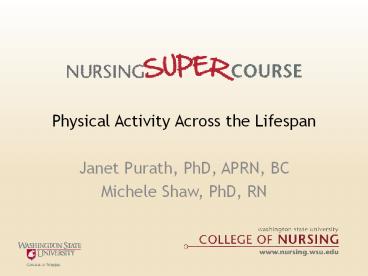Physical Activity Across the Lifespan - PowerPoint PPT Presentation
Title:
Physical Activity Across the Lifespan
Description:
Physical Activity Across the Lifespan Janet Purath, PhD, APRN, BC Michele Shaw, PhD, RN * As we have improved health conditions world-wide, there has been a shift in ... – PowerPoint PPT presentation
Number of Views:196
Avg rating:3.0/5.0
Title: Physical Activity Across the Lifespan
1
- Physical Activity Across the Lifespan
- Janet Purath, PhD, APRN, BC
- Michele Shaw, PhD, RN
2
Objectives
- Describe physical activity levels across the
lifespan and across the globe - Discuss types of physical activity
- Discuss health benefits of physical activity
3
Importance of Changing Health Behaviors
- Shift from infectious disease to chronic and/or
degenerative illnesses emphasizes the need for
primary, secondary and tertiary prevention - Healthy behaviors lead to
- Increased longevity
- Reduced disability rates
- Better mental health and cognitive function
- Lower healthcare costs
4
Definition and Significance
- Physical activity
- Defined as any bodily movement produced by
skeletal muscles that requires energy
expenditure. - Lack of physical activity is an independent risk
factor for chronic diseases, and overall is
estimated to cause 1.9 million deaths globally. - Source WHO Global Strategy on Diet, Physical
Activity and Health
5
Physical InactivityA Global Public Health
Problem
6
Why are people inactive?
http//www.wcc-coe.org/wcc/what/jpc/pictures/mumba
i1-low.gif
cai.blogware.com/_photos/Smog.jpg
7
Physical Activity Recommendations
- Everyone should participate in a minimum of 30
minutes of physical activity every day. - Young people are encouraged to aim for 60 minutes
of physical activity per day.
8
Modes of Physical Activity
- Lifestyle
- Work
- Leisure
- Household
- Transportation
- Exercise
9
Types of Physical Activity
- Aerobic
- Muscle strengthening
- Bone Strengthening
- Balance
- Flexibility
10
Risk Populations
- Global trends in physical inactivity are of
particular concern in certain high risk
populations Older adults, women and young
people. - http//www.who.int/dietphysicalactivity/pa/en/inde
x.html
11
Older Adults
- World-wide population is aging.
- By 2030, 55 countries are expected to see their
65 and older populations at least 20 percent of
their total. - By 2040, the global population is projected to
number 1.3 billion older peopleaccounting for 14
percent of the total.
12
Evidence of Benefits for Older Adults
- Improved
- Function and quality of life
- Balance and strength
- Coordination and motor control
- Flexibility
- Endurance
- Mental health and cognition
- Decreases risk of falls
- More interaction with people of all ages
13
Sarcopenia
- Definition
- Consequences
- decreased in resting energy expenditure
- decreased insulin sensitivity
- diminished muscle strength
- increased risk of disability and falls
- increased risk for mortality
14
Recommendations
- Older adults should engage
- in moderate intensity activity at least 150
minutes or 75 minutes of vigorous activity per
week - in strength activities 2 or more days per week.
- in balance activity if they have risk for falls
- Source 2008 Physical Activity Guidelines for
Americans
15
Physical Activity and Women
- Why is this important?
- Benefits
- Decrease in specific diseases
- Improved mental health and self esteem
16
Barriers
http//www.free-stockphotos.com/images/stretching-
woman.jpg
17
Activity for Low-income and Rural Women
http//www.waterencyclopedia.com/Da-En/Developing-
Countries-Issues-in.html
18
Physical Activity and Young People
- Why is this important?
- Active children are more likely to grow up to be
active adults. - Increased activity positive health outcomes
- Controlling weight
- Decreasing blood pressure
- Lessons risk of diabetes some cancers
- Reduces asthma symptoms and severity
- Psycho-social benefits
19
Physical Activity and Young People
- All children ages 2 and older should participate
in at least 30 minutes of age appropriate
physical activities every day. - 5-18 year olds should aim for a minimum of 60
minutes of moderate to vigorous physical activity
each day.
20
Definitions for Young People
- Aerobic
- Muscle Strengthening
- Bone Strengthening
21
What activities count?
- Moderate Intensity Aerobic Activities
- Children
- Bicycle riding
- Walking
- Active recreation
- Adolescents
- Yard work or house work
- Playing games involving catching/throwing
- Brisk walking
- Active recreation
22
What activities count?
- Vigorous-Intensity Aerobic Activities
- Active games including running chasing
- Bicycling
- Running
- Vigorous Dancing
- Sports (swimming, basketball, soccer)
23
What activities count?
- Bone-Strengthening Activities
- Jumping, hopping, skipping
- Running
- Jumping rope
- Sports gymnastics, basketball, volleyball,
futbol
24
Encouraging Physical Activity Among Young People
- Adults as positive role models
- Provide equipment
- Encourage play with friends
- Make activity part of family life
- Require safety (bike helmets, wrist/knee pads,
traffic issues, environmental considerations)
25
http//office.microsoft.com/en-us/images/
26
Summary
- Increasing Physical Activity across the lifespan
and across the globe can significantly improve
world health.
27
Contact Information
- Michele Shaw, PhD, RN
- michele_shaw_at_wsu.edu
- Janet Purath, PhD, APRN, BC
- jpurath_at_wsu.edu






![[PDF] Growth and Development Across the Lifespan 3rd Edition Ipad PowerPoint PPT Presentation](https://s3.amazonaws.com/images.powershow.com/10079281.th0.jpg?_=20240716061)
























